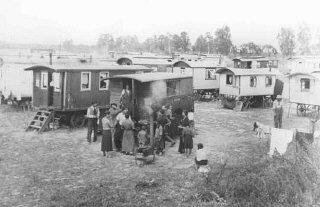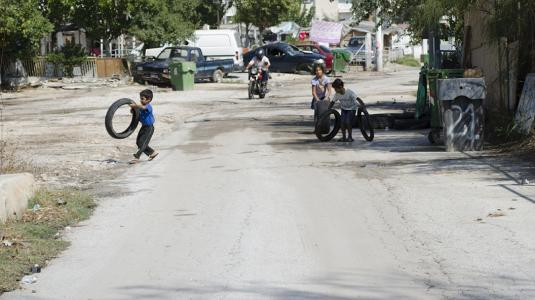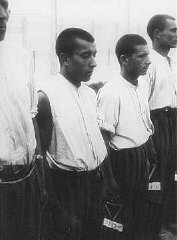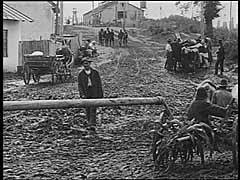
Marzahn, the first internment camp for Roma (Gypsies) in the Third Reich. Germany, date uncertain.
Among the groups the Nazi regime and its Axis partners singled out for persecution on so-called racial grounds were the Roma (Gypsies).
Drawing support from many non-Nazi Germans who harbored social prejudice towards Roma, the Nazis judged Roma to be "racially inferior." The fate of Roma in some ways paralleled that of the Jews. Under the Nazi regime, German authorities subjected Roma to arbitrary internment, forced labor, and mass murder. German authorities murdered tens of thousands of Roma in the German-occupied territories of the Soviet Union and Serbia and thousands more in the killing centers at Auschwitz-Birkenau, Chelmno, Belzec, Sobibor, and Treblinka. The SS and police incarcerated Roma in the Bergen-Belsen, Sachsenhausen, Buchenwald, Dachau, Mauthausen, and Ravensbrück concentration camps. Both in the so-called Greater German Reich and in the so-called Generalgouvernement, German civilian authorities managed several forced-labor camps in which they incarcerated Roma.
On September 21, 1939, Reinhard Heydrich, head of the Reich Security Main Office, met with Security Police (Sipo) and Security Service (SD) officials in Berlin. With German victory in the invasion of Poland assured, he intended to deport 30,000 German and Austrian Roma from the Greater German Reich to the Generalgouvernement (that part of German-occupied Poland not annexed directly to Germany). Governor General Hans Frank, the top civilian occupation official in the Generalgouvernement, foiled this plan when he refused to accept large numbers of Roma and Jews into the Generalgouvernement in the spring of 1940.
German authorities did deport some Roma from the Greater German Reich to occupied Poland in 1940 and 1941. In May 1940, the SS and police deported approximately 2,500 Roma and Sinti, primarily residents of Hamburg and Bremen, to Lublin District in the Generalgouvernement. SS and police authorities incarcerated them in forced labor camps. The conditions under which they had to live and work proved to be lethal to many of them. The fate of the survivors is unknown; it is likely that the SS murdered those who were still alive in the gas chamber of Belzec, Sobibor, or Treblinka. In the autumn of 1941, German police authorities deported 5,007 Sinti and Lalleri Gypsies from Austria to the ghetto for Jews in Lodz, where they resided in a segregated section. Nearly half of the Roma died within the first months of their arrival, due to lack of adequate food, fuel, shelter, and medicines. German SS and police officials deported those who survived these dreadful conditions to the killing center at Chelmno in the first months of 1942. There, along with tens of thousands of Jewish residents of the Lodz ghetto, the Roma died in gas vans, poisoned by carbon monoxide gas.
Intending to deport them from the so-called Greater German Reich in the near future, German authorities confined all Roma in so-called Gypsy camps (Zigeunerlager). With the suspension of deportations of Roma in 1940, these facilities became long-term holding pens. Marzahn in Berlin along with Lackenbach and Salzburg in Austria were among the worst of these camps. Hundreds of Roma died as a result of the horrendous conditions. Local Germans repeatedly complained about the camps, demanding the deportation of the Roma interned there in order to "safeguard” public morals, public health, and security. Local police used these complaints to appeal officially to Reichsführer-SS (SS chief) Heinrich Himmler for the resumption of deportations of Roma to the east.
In December 1942, Himmler ordered the deportation of all Roma from the so-called Greater German Reich. There were exceptions for certain categories, including people of “pure Gypsy blood” dating from ancient times, persons of Gypsy descent who were considered integrated into German society and therefore did not “behave like Gypsies,” and persons (and their families) who had distinguished themselves in German military service. At least 5,000 and perhaps as many as 15,000 persons fell under these exemptions, although local authorities often ignored the distinctions during roundups. Police authorities even seized and deported Roma soldiers serving in the German armed forces (Wehrmacht), while they were home on leave.
In general, the German police deported Roma in the Greater German Reich to Auschwitz-Birkenau, where the camp authorities housed them in a special compound that was called the "Gypsy family camp." Some 23,000 Roma, Sinti and Lalleri were deported to Auschwitz altogether. In the so-called Gypsy compound, entire families lived together. SS medical researchers assigned to the Auschwitz complex, such as SS Captain Dr. Josef Mengele, received authorization to choose human subjects for pseudoscientific medical experiments from among the prisoners in the Auschwitz concentration camp complex. Mengele chose twins and dwarves, some of them from the Gypsy family camp, as subjects of his experiments. Approximately 3,500 adult and adolescent Roma were prisoners in other German concentration camp; medical researchers selected subjects from among the Roma incarcerated in Ravensbrück, Natzweiler-Struthof, and Sachsenhausen concentration camps for their experiments, either on site in the camps or at nearby institutes.
Conditions in the Gypsy compound at Auschwitz-Birkenau were contributed to the spread of infectious disease and epidemics--typhus, smallpox, and dysentery—which severely reduced the camp population. In late March, the SS murdered approximately 1,700 Roma from the Bialystok region in the gas chambers; they had arrived a few days earlier and many, though by no means all, were ill. In May 1944, the camp leadership decided to murder the inhabitants of the Gypsy compound. The SS guards surrounded and sealed off the compound. When ordered to come out, the Roma refused, having been warned and having armed themselves with iron pipes, shovels, and other tools used for labor.
The SS leaders chose not to confront the Roma directly and withdrew. After transferring as many as 3,000 Roma capable of work to Auschwitz I and other concentration camps in Germany in the late spring and early summer of 1944, the SS moved against the remaining 2,898 inmates on August 2. Most of the victims were ill, elderly men, women, and children. The camp staff killed virtually all in the gas chambers of Birkenau. A handful of children who had hidden during the operation were captured and killed in the following days. At least 19,000 of the 23,000 Roma sent to Auschwitz died there.
In German-occupied of Europe, the fate of Roma varied from country to country, depending on local circumstances. The German authorities generally interned Roma and deployed them as forced laborers in Germany or transported to Poland to be deployed at forced labor or to be killed. In contrast to German policy towards German and Austrian Jews, in which people of so-called mixed blood were exempted from deportation measures (though not from forced labor), the SS and police, after much waffling and confusion, decided that “Gypsies” of “pure blood” were harmless and that the “half-breeds,” regardless of the percentage of “mixture” of blood, were dangerous and hence deportable.
German military and SS-police units also shot possibly at least 30,000 Roma in the Baltic States and elsewhere in the occupied Soviet Union, where Einsatzgruppen and other mobile killing units killed Roma at the same time that they killed Jews and Communists. In occupied Serbia, the German authorities killed male Roma in shooting operations during 1941 and early 1942; then murdered the women and children in gas vans in 1942. The total number of Roma killed in Serbia will never be known. Estimates range between 1,000 and 12,000.
In France, Vichy French authorities intensified restrictive measures against and harassment of Roma after the establishment of the collaborationist regime in 1940. In 1941 and 1942, French police interned at least 3,000 and possibly as many as 6,000 Roma, residents of both occupied France and unoccupied France. French authorities shipped relatively few of them to camps in Germany, such as Buchenwald, Dachau, and Ravensbrück.
While the authorities in Romania, one of Germany's Axis partners, did not systematically annihilate the Roma population living on Romanian territory, Romanian military and police officials deported around 26,000 Roma, primarily from Bukovina and Bessarabia, but also from Moldavia and Bucharest, the capital, to Transnistria, a section of south western Ukraine placed under Romanian administration, in 1941 and 1942. Thousands of those deported died from disease, starvation, and brutal treatment.
The authorities of the so-called Independent State of Croatia, another Axis partner of Germany and run by the militant separatist and terrorist Ustasa organization, physically annihilated virtually the entire Roma population of the country, around 25,000 people. The concentration camp system of Jasenovac, run by the Ustasa militia and the Croat political police, claimed the lives of between 15,000 and 20,000 Roma.
It is not known precisely how many Roma were killed in the Holocaust. While exact figures or percentages cannot be ascertained, historians estimate that the Germans and their allies killed around 25 percent of all European Roma. Of slightly less than one million Roma believed to have been living in Europe before the war, the Germans and their Axis partners killed up to 220,000.
After the war, discrimination against Roma continued throughout Central and Eastern Europe. The Federal Republic of Germany determined that all measures taken against Roma before 1943 were legitimate official measures against persons committing criminal acts, not the result of policy driven by racial prejudice. This decision effectively closed the door to restitution for thousands of Roma victims, who had been incarcerated, forcibly sterilized, and deported out of Germany for no specific crime. The postwar Bavarian criminal police took over the research files of the Nazi regime, including the registry of Roma who had resided in the Greater German Reich.
Only in late 1979 did the West German Federal Parliament identify the Nazi persecution of Roma as being racially motivated, creating eligibility for most Roma to apply for compensation for their suffering and loss under the Nazi regime. By this time, many of those who became eligible had already died.



















